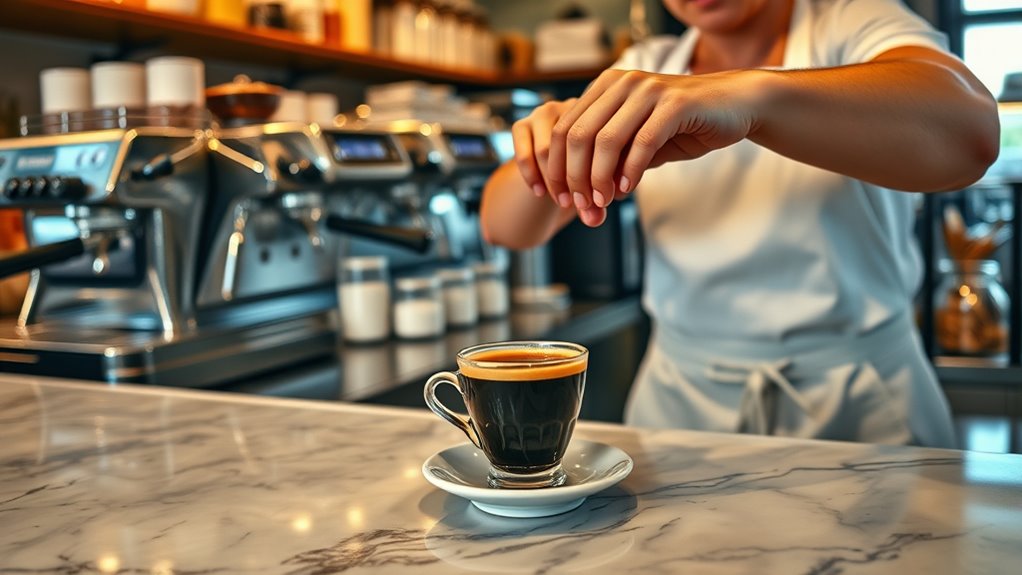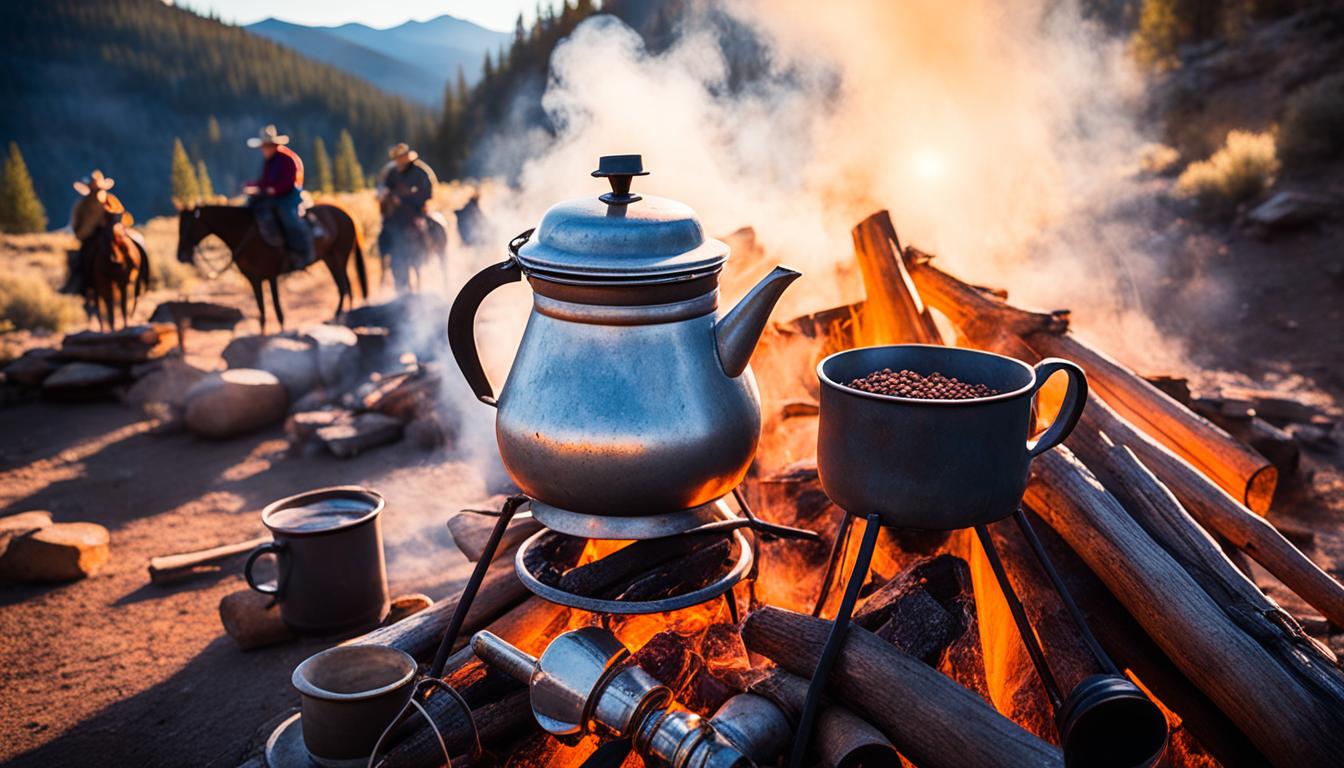In Italy, coffee is a cherished tradition with specific etiquette to follow. You should enjoy your espresso quickly at the bar, standing to embrace the lively pace, or sit down only if you’re having a leisurely moment, often paying more. Milk-based drinks are mainly for mornings, and regional customs vary—Southern Italy favors longer social coffee breaks, while Northern cities prefer efficiency. Embracing these customs helps you blend in—keep exploring to discover the full coffee experience.
Key Takeaways
- Italians typically enjoy espresso quickly at the bar, standing, as part of their daily routine.
- Sitting down with coffee usually indicates a leisurely experience, often with higher prices.
- Milk-based drinks like cappuccino are reserved for mornings; avoid ordering them later in the day.
- Polite ordering etiquette includes using “per favore” and respecting local customs and presentation styles.
- Regional differences influence coffee customs, with faster northern cities and more social southern regions.

Italian coffee culture is a vibrant and integral part of daily life, shaping social interactions and personal routines. When you step into a local café, you’ll quickly notice the importance of adhering to coffee etiquette. Italians take their coffee seriously, and there are unwritten rules you’re expected to follow. For instance, ordering an espresso means you’re likely to enjoy it quickly at the bar, standing up, rather than lingering at a table. Sitting down with a coffee often indicates a more leisurely experience, which might come with a different price. Recognizing these nuances helps you blend seamlessly into the local scene. Understanding coffee etiquette is essential to appreciating how Italians enjoy their daily ritual. Regional variations also play a significant role in shaping coffee customs across Italy. In the north, particularly in cities like Milan, coffee culture is fast-paced, with a focus on efficiency. Here, grabbing a quick espresso on your way to work is common, and cafes tend to be sleek and modern. In contrast, southern Italy embraces a more relaxed approach, where coffee is often enjoyed over longer conversations and at a slower pace. Sicily, for example, has a unique tradition of sweet, strong espresso-like drinks, sometimes flavored with local ingredients like citrus or spices. These regional differences extend to how coffee is served and consumed, so what’s typical in Rome might differ from what you experience in Naples or Florence. Understanding and respecting these regional variations will deepen your appreciation of Italian coffee etiquette. In Venice, cafes might serve coffee with a focus on presentation, and it’s customary to order your drink with a polite “per favore” (please). In smaller towns, locals often prefer simple, no-frills coffee, valuing tradition over trend. Italians also have particular preferences for how their coffee is prepared—an espresso shot is typically short and strong, served in a small cup to enhance the rich flavor. Additionally, the coffee serving styles can vary depending on local customs, which is worth noting when exploring different regions. Milk-based drinks like cappuccino are usually reserved for mornings; ordering one after breakfast or in the afternoon might be considered unusual or even frowned upon.
Frequently Asked Questions
How Do Italians Order Coffee at a Bar Versus a Café?
When you order coffee at a bar in Italy, you typically say what you want quickly and pay immediately, as it’s quick and casual. At a café, you might sit down and order more leisurely, enjoying the coffee at your table. Italian coffee etiquette differs between the two; at the bar, it’s about efficiency, while at a café, it’s about savoring the experience. Always remember to be polite and clear about your order.
What Are the Unspoken Rules About Drinking Coffee in Italy?
Think of coffee etiquette in Italy as a sacred dance—you follow unspoken rules that keep the rhythm smooth. You should sip your espresso quickly at the bar, especially in the morning, and avoid taking it to-go like in other countries. Drinking cappuccino after 11 am is taboo, and you never request sugar after your first sip. Respect these customs, and you’ll blend seamlessly into Italy’s vibrant coffee scene.
Are There Specific Times When Certain Coffees Are Preferred?
You’ll find that timing traditions influence when you enjoy different coffees in Italy. For example, you typically have a quick espresso in the morning or after meals, fitting into your daily routines. Avoid ordering a cappuccino later in the day, as it’s seen as a morning treat. Sticking to these customs helps you blend seamlessly into local life and shows respect for Italy’s coffee etiquette.
How Has Italian Coffee Culture Evolved Over the Past Century?
Over the past century, Italian coffee culture has evolved with new coffee bean varieties and espresso machine innovations shaping your experience. You’ve seen a shift from traditional methods to modern techniques, making espresso more accessible and varied. While the core rituals remain, you now enjoy a broader range of flavors and brewing styles, blending tradition with innovation, all while maintaining Italy’s deep-rooted love for quality coffee.
Do Italians Prefer Their Coffee Black or With Milk?
Like a classic opera, your coffee preferences tip the scales—are you more drawn to the intensity of black or the creaminess of milk? Italians generally favor their coffee black, savoring the pure espresso shot that embodies tradition. However, many also enjoy milk-based drinks like cappuccino, especially in the morning. So, whether you prefer bold black or smooth milk, your choice reflects your personal taste within Italy’s rich coffee culture.
Conclusion
As you embrace Italy’s coffee rituals, you become part of a lively symphony of aromas, sips, and shared moments. Each espresso is a quick heartbeat in the bustling heartbeat of Italy’s streets, a dance of tradition and taste. When you savor your coffee the Italian way, you tap into a timeless rhythm that whispers stories of passion, precision, and community. So, let your coffee journey flow like a melodic Italian aria—full of life and flavor.









